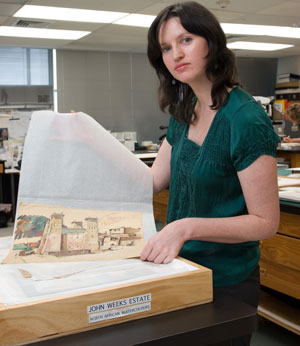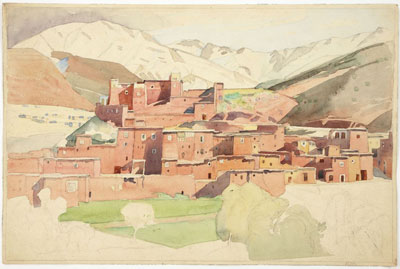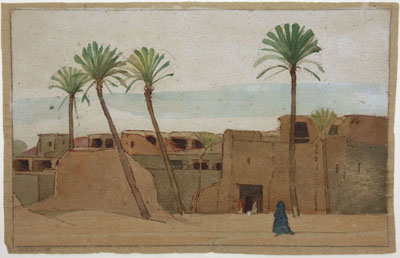Wednesday 19 January 2011
Amy Cooper
Late last year Kyla Mackenzie joined the Gallery team as one of our two Marylyn Mayo interns (you can find out more about the internships here). I asked Kyla to tell us a bit about herself and the project she's working on, which involves delving through a large collection of artworks that have barely been seen - until now.

Kyla in the conservation lab. Photo: Jennifer French
Tell me about the project(s) you’re working on during this internship.
This Marylyn Mayo internship involves photographing, cataloguing and researching a selection of mainly works on paper by former Elam teacher John Weeks. From 1927 to 1928, 'Johnny' travelled with a friend through North Africa, particularly Morocco, but also Algeria and Tunisia. These North African works form part of a recent gift from the Peter O'Connor Estate to the Gallery. This archive from Weeks' studio includes hundreds of works from his travels through Europe, as well as New Zealand subjects. Only a handful of people have seen any of these works, so I feel quite privileged.
What's your background? How did you come to apply for the internship?
My background in the arts is varied and ranges from working in dealer galleries, the community arts, and free-lance art biographical research. I also worked for a few years in the British Watercolours and Drawings and later, the Paintings Department at Sotheby's in London. That was an eye-opener. There were many works by travelling British artists of the 18th and 19th centuries. The specific phenomenon of the 'West' seeking novel material in the 'East' was also a subject I studied prior to my M.A in art history and is helpful in contextualising Weeks' enthusiasm and artistic output.
What interests you about this subject/project?
There are many areas of interest for me in this project and more will emerge.
I have a soft spot for works on paper. Weeks used, in particular, watercolour, pencils, inks, and pastels, which he employed in quite diverse and compelling ways.
It's always satisfying to research little seen works. These images are by an important New Zealand modernist, felt by many to have been over-looked thus far. Weeks played such a pivotal role in New Zealand's history of art and former students still have very fond memories of him. He lost, and we lost, three hundred of what he regarded to be his best works in an Elam fire in 1949. However, we have now gained a valuable resource, many images of which informed much of his future oeuvre. Weeks regarded his (often risky) North African travels as a great adventure, and very satisfying in terms of visual material. Weeks was a great colourist and clearly delighted in the light and colour of North Africa which is a pleasure to see.
What are the challenges you’ll be facing?
The photographing of hundreds of works is actually quite physical work and a new experience all round for me. There is also a great deal of material both visual and textual. The numbers of works in the boxes remain unclear at this point, and there is limited time to go through it, consider it, research it, present it to the Gallery team, and write about it. The brief is, however, to cover as much as is possible in the time.

John Weeks, Asni, c.1927-8, watercolour and pencil
John Weeks Archive, E.H. McCormick Research Library, gift of The Estate of Peter O’Connor, 2010.
What do you hope to get out of it personally?
I want, as do all interns, to build on skills and experience already gained and to acquire further hands-on experience in a satisfying project. I'd like to see if this material allows for more research and writing. There are woefully few paid internship opportunities in this country to develop skills in the public gallery world, so it is a rare thing indeed. (To be able to eat over the summer was of considerable personal advantage also!)
What was the application process like?
I found it fine and an enjoyable challenge in itself. Prompt referees certainly ease the process. There is quite a bit of hard-copy documentation required, which includes a piece of writing relevant to the project. The interview, however, was unexpectedly nerve-wracking, despite having volunteered at the Gallery previously. Fortunately, any weak jokes were kindly overlooked...

John Weeks, Oudaghir, c.1927-8, watercolour, pencil and red ink
John Weeks Archive, E.H. McCormick Research Library, gift of The Estate of Peter O’Connor, 2010.